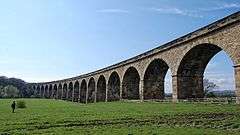Arthington Viaduct

Arthington Viaduct, also known as Castley Viaduct and listed as the Wharfedale Viaduct, carries the Harrogate Line across the Wharfe valley between Arthington in West Yorkshire and Castley in North Yorkshire, England. It is a Grade II listed structure.[1]
The viaduct was built, between 1845 and 1849, in a curve some 500 yards (460 m) in length, with 21 semi-circular arches on high piers. Construction was supervised by Chief Engineer of the Leeds and Thirsk Railway Thomas Grainger, who built the line from Leeds to Stockton-on-Tees via Harrogate and Thirsk. The foundation stone was laid on 31 March 1846 by Henry Cooper Marshall, Chairman of Leeds and Thirsk Railway Company and the line opened on 10 July 1849 when the nearby Bramhope Tunnel, another key component of the line, was complete. In excess of 50,000 tons of stone were used in its construction.
Dimensions
- Span of arch: 60 ft (18.2 m)
- Rise of arch: 21 ft (6.4 m)
- Greatest height: 90 ft (27 m)
- Lowest height: 60 ft (18 m)
- Length of viaduct: 1510 ft. (460.2 m)
- Width of roadway: 30 ft (9.1 m)[2]
References
- ↑ Historic England. "WHARFEDALE VIADUCT (1253368)". National Heritage List for England. Retrieved 12 January 2016.
- ↑ "Wharfedale (Arthington) Viaduct". National Railway Museum. Retrieved 12 January 2016.
| Wikimedia Commons has media related to Arthington Viaduct. |
Coordinates: 53°54′21″N 1°36′02″W / 53.90576°N 1.60050°W